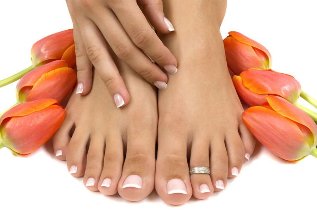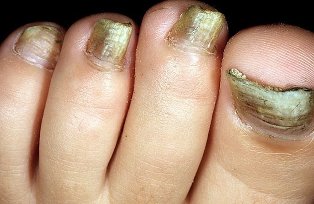Many do not even suspect that the buyer of the sweating of the feet, accompanied with unpleasant smell, which has more than half of the population of the planet, one of the main symptoms of nail fungus. This disease runs the risk of becoming sick with each one, although a bit neglected their personal hygiene. Nail fungus is lurking everywhere, especially in the common areas. And the worst thing is the fact that the fungus of the nails — quite insidious of the disease: the long-term treatment, and is not always successful, as well as the athlete's foot is inclined to recidivism. To be able to recognize the disease and begin treatment, you must know all of the signs of the fungus on the feet.

How is the disease spread?
The infection-causing parasites fungi. It is an ideal environment for reproduction and development — the increase of humidity in combination with a warm atmosphere. It is considered that the main places where it is high risk to be infected by nail fungus, this baths, saunas, water parks, swimming pools, manicure, etc, However, the statistics for anything, belies these claims: nail fungus can be attached to the house through the common stuff (towels, shoes, clothes, carpets, shower cabin or bath), if any of the members of the family already has this problem, or at a party, for example, through slippers, proposed by the teacher (and may not even suspect that he has the disease).
But what factors influence the development of fungal disease? He emphasized that these the basic considerations that lead to the infection onychomycosis:
- the decrease of the immunity;
- lesions on the surface of the nail;
- violation of the circulation of the blood in the lower extremities, which can occur when wearing a tight shoe;
- the pathology of the stop anatomical in nature;
- obesity;
- diabetes mellitus;
- increased sweating.
Although, in part, to protect yourself, you should use only your things, handle it with care antiseptic bath and shower, enjoying a towel, to clean and wash carpets, shoes cleaned. And in order not to lose favorable for the treatment of mycosis moment (as all the world knows that the most effective therapy in the initial phase of development of the disease), it is necessary to know the early symptoms of fungus in the nails of the feet.
How to recognize onychomycosis?
Symptoms of nail fungus at different stages may be distinguished one from another, indicating the progression of the infection. For example, in the first (early) phase of any of the symptoms are practically non-existent. In the plate of the nail you can see barely visible whitish spots or stripes. These symptoms should alert you, because you can talk about the existence of a fungal infection. If you ignore the first signs of the disease, there is the risk of starting a mushroom, that he will have healthy fingernails and take in the future to the appearance of pus in the periungual tissues, and this is a threat of gangrene and amputation of the lower extremities.
The second degree of the fungal disease of the nails is manifested by the lack of natural luster of the surface of the nail. Following nail changes color, appearing yellow, the white and the brown of the band. Can warp the top of the nail and side of their plots. These symptoms you can see in the photo.
Initiated the stage of onichamicosis is characterized by the fragility and the surface of the nail, inflammation of the cuticle. Occurs the risk of loss of the nail. But what's most worrisome is that the disease continues to spread to other nails of the lower extremities, as well as in the skin of stop. The treatment in this case, you must begin immediately in order to avoid the unpleasant consequences of the disease.

The second and third phase of onichamicosis the patient can recognize himself: the nail acquires a yellow tint, or mud brown in color, it becomes clumpy and thick, behind the nail, it becomes very brittle and fragile. Sometimes, the use of closed shoes becomes painful and itching of the skin — the unbearable (this particular symptom is increased with the increase of sweating). In addition, to cause suspicion of onychomycosis can these accompanying symptoms, which manifest in the skin, close to the uas:
- a burning sensation;
- intolerant itching;
- the flaking and dryness;
- the inflammation;
- crying spotlights;
- the thickening and keratinization.
To recognize the early symptoms of nail fungus, you should consult a specialist, who will appoint a optimal scheme of treatment.
As seen in the different types of onichamicosis?
Define 3 types of onichamicosis, each of which is manifested in their features.
- Normotroficheskie nail fungus is characterized by the change of color of the surface of the nail: a patient of the nail can have tones ranging from white to dark green. In the first phase of the disease in the nail appear white, round or longitudinal spots. With the progression of the disease tone of the nails can vary, and that the fungus extends to the entire area of the surface of the nail. However, its thickness does not change, yes, and the natural glow of the saved.
- Hypertrophic nail fungus manifests itself in the change of color of the surface of the nail, loss of luster of the surface, strong reinforced and deformation. The nails of the feet very exfoliating, begins their destruction.
- Atrophic fungus is characterized by the change of color of the nail with the others in your slimming. The result of this fungal of defeat is the refusal of the patient of the nail, or a plot.
To determine the presence of nail fungus, you can, however, to establish an accurate diagnosis can be a specialist. To do this, you should visit the clinic, to deposit in the analysis of scrapings of the sick nails or skin, spreads around him. In addition, dermatologist assigned to the research microscpica.
The signs of the fungus the pathogen of the disease
The success of the treatment of nail fungus depends on what and how they are diagnosed, the causal agent of the disease. This is because the disease causes a type of fungi, but several, and each one of them sensitive to certain drugs. That is to say, if a fungus is resistant to one drug, another causative agent of this tool of the story.

More nail fungus cause:
- yeast;
- exerts the action antifungal;
- the mold.
If the cause of nail fungus steel of the yeast, is to detect the disease at once almost impossible. Symptoms of fungus in the nails of the feet, in this case, are the following (which are manifest after a long period of time): peeling of the surface of the nail, and slight itching of the skin around the nail (the itching can be missing). The nail infection of yeast is located in the 4-4,5% of the cases.
Exerts the action antifungal affect the nails of the person more than in the previous the causal agent is 94.5% of the cases of infection by the fungus of the nails. Exerts the action of antifungal may be of three types, the infection of each one of them manifests itself in different ways:
- For the first type is characteristic integral of the defeat of the strike, the feet and the nails. The fungus spreads easily on the skin and nails of the hands.
- The second type affects only the nail of the little finger or the thumb of the foot. Can be applied to interdigital folds, and as all the fingers, and some.
- The third type is characteristic of the defeat of the nails of the thumb and little finger, however, the epidermis of the fungus does not affect.
The last type of mold — mildew. Your agent — molds. Is this disease only 1% of the cases. Develops the fungus of this type more often in hiv-positive people.
Other symptoms of fungal infection of the nails
Often, at the beginning of the disease, clear signs of fungal of the defeat of the nails are missing. However, if you be attentive you can notice changes in the structure of the nail and its exterior appearance. As already mentioned above, the nail plate may appear longitudinal or round whitish color of the stain, the nail can be curved, its softness and brightness is lost. Progressively, the disease that most destroys the nail plate: first change your color, and then the surface of the nail becomes scaly, thickened, or becomes thin, exfoliates, breaks down. Nail Color depends on what type of fungus was the cause of the infection.
In addition to the main features of the onichamicosis, there are others:

- the fragility of the edges of the nail surface or on its entire surface;
- the distortion of the shapes of the nails, with the modification of its structure;
- blackening of the nail;
- deepening of the nails under the skin;
- systemic, drowsiness, general weakness;
- detachment of the nail plate, which leads to the formation of plaque underneath the nail whitish or yellow in color with unpleasant odor;
- the itching, cracking, burning sensation of the skin in the proximity surprised with the nail;
- systemic, drowsiness, general weakness.
Any variation in the appearance of the nails of the feet should be alert, as this can talk about the development of nail fungus. The first action, in this case, the hike to a dermatologist, who will confirm or refute your fears. If this is not done immediately, the disease will progress. At first glance, nothing happens in this disease does not exist. However, in addition to the purely aesthetic problems and discomfort, the fungus may cause serious complications, up to purulent infection affected areas and even the development of gangrene. Therefore, do not tighten with treatment, you should take immediate action, since the disease has been detected.





























